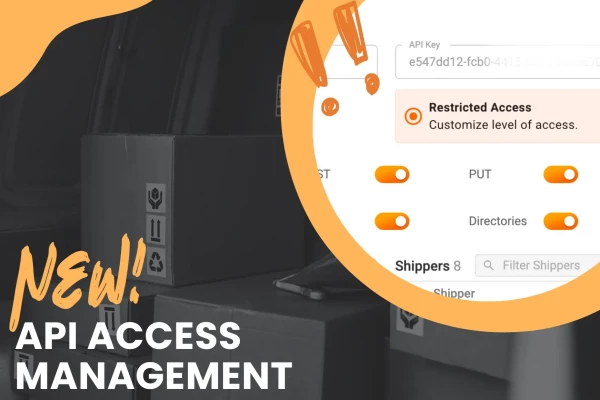Multimodal Transportation: Definition, Challenges, and Solutions

by
Alisa Cvilij
June 20, 2024
The transportation industry is huge. This is true for its market size, geographical reach, variety of modes of transport, types of transportation services, and the number of shippers involved in supply chains worldwide.
Today, we're exploring multimodal transportation: what it is and the difference between multimodal and intermodal transportation. We'll examine some of the biggest challenges related to multimodal transportation and offer some solutions.
Let's roll.
Table of content
- What is multimodal transportation?
- What is intermodal transportation?
- Benefits of multimodal transportation
- What types of multimodal transportation would you use?
- Multimodal transportation challenges and solutions
What is multimodal transportation?
Multimodal transportation refers to logistics and freight processes that require multiple modes of transportation.
For example, one shipment may involve rail carriers, air cargo freight, and a truck carrier. These are three modes of transport used in combination to complete a shipment.
- Multimodal transport is handled by a single carrier, which is a multimodal transport operator or provider. The provider relies on a network of smaller carriers or contractors to do the job. However, it's still a single-contract process for the shipper opting for multimodal transport.
Unlike intermodal shipping, multimodal shipping allows for the cargo to be handled differently. This depends on the responsible carrier. For example, because of multimodal transport constraints, the freight will be moved from a container to pallets in a truck.

What is intermodal transportation?
To fully define multimodal transportation, we must establish what intermodal shipping means.
Intermodal transportation also requires the coordination of multiple modes of transport.
The difference is that you have to deal with multiple carriers and separate contracts.
The key part of an intermodal shipment is that carriers handle one and the same freight container. Each carrier does its part in getting the container to the destination, but they don't get to remove cargo from one container and put it in a different carriage.
- The main benefit of intermodal shipping is that it's cheaper than multimodal transport. However, negotiations with carriers require more time. Much like supplier relationship management, it can add a huge chunk of work to an already busy logistics operation.
Companies opt for multimodal shipping because they prefer to deal with just one contractor instead of many. Let's look at some other benefits this type of freight offers.

Benefits of multimodal transportation
In addition to making the entire shipping process easier in terms of contract obligations, multimodal shipping comes with additional benefits.
Communication
First and foremost, we need to discuss coordination. Multimodal movement wins over intermodal movement due to much clearer communication. Talking to one carrier company or service is enough to complicate freight logistics. Coordination with multiple carriers can decrease efficiency and delay loading and shipment.
Keeping the movement down to a single contract means better overall control of transit and less contracts-related work for your legal department.
Accountability
Speaking of contractual obligations, a multimodal movement also means that only one agent or provider is responsible for the movement of the freight. The tricky part of managing a supply chain is tracking and holding individual shippers and suppliers accountable for delays and wasted resources.
Having one agent responsible for the freight is even referred to as "door-to-door" coverage, meaning your shipment is secured by one company. A single-contract mode will save you freight management hours and reduce operational costs.
Accessibility
Unless you're shipping fragile freight or any freight across the ocean, which entails movement between ports, keeping the cargo in one container means worse access for the carriers. Meanwhile, a combination of different modes of transport means that each mode comes with its own constraints.
Multimodal and intermodal shipping will both get the cargo to its destination. Do you really need to limit each carrier's access to the transit options at the cost of delays?
Deadlines
Delivery is good when it's on-time. Supply chain efficiency, logistics management, and customer satisfaction all depend on meeting shipping deadlines. A clear benefit of multimodal movement is that it minimizes delivery delays by giving one company control over the entire freight.
Door-to-door, after all, means that shippers and carrier providers are on the same page with shipments are order fulfillment. Going with multimodal shipping over intermodal shipping helps you reduce the risk of delays and keep customer satisfaction consistently high.

When would you use a multimodal transportation network?
Multimodal solutions make sense when cargo has to travel long distances. It is also practical for cargo that has to be separated further down the line. This may be for loading purposes, or when goods are traveling to different destinations.
What types of multimodal transport would you use?
Most multimodal shipping starts off with road transport. Some companies have railway sidings on their premises and load their cargo directly onto train carriages.
Trains would typically transport containers to a seaport or to another siding, where the goods are loaded onto trucks.
Regarding raw materials, trains and trucks carry bulk loads to manufacturing sites for further processing. Farm produce is transported in bulk and offloaded at markets.
In the timber industry, huge logs are floated down a river or loaded onto trucks and trains bound for sawmills.
- Trains are a practical solution for long-distance bulk transportation. They’re more environmentally friendly in countries that don’t use coal-powered trains.
- Trucks are a more practical answer to transportation as their reach is much wider and more flexible. They deliver cargo to airports, seaports, factories, businesses, or private customers.
- Multimodal logistics means that cargo does not necessarily need to be kept in the same container it was originally packed in. The cargo may start off in a container and be unpacked at the airport before loading onto planes.
- Sea transportation is generally done in shipping containers. Containers can be shared by more than one company or individual. In this case, goods would be transported to a depot by road and loaded into a container.
Alternatively, items are packed into containers by the supplier. Upon reaching the destination country, they will be split into different deliveries for truck or rail transportation.
Multimodal transportation challenges and solutions
Now that we've discussed the benefits of multimodal shipment let's examine the challenges presented by multimodal and intermodal transportation and the solutions shippers and carrier companies seek.
Excessive paperwork
Even though intermodal and multimodal movements differ in terms of the number of contracts you have to deal with, multimodal shipping can still be bothersome regarding paperwork. For example, you've settled on a carrier company that handles multimodal transport for you. Your job as a shipper is done here, right?
The bad news is that the company can still invoice you for different services, i.e., each leg of transportation. As you spend more and more time processing each paper invoice, the overall shipping cost keeps growing. This is a sign that the transport and logistics industry should go paperless.
Challenge: paper invoices for different services individually.
Solution: paperless delivery management systems that support e-sign and photo proof of delivery.
Poor tracking & coordination
In long-haul freight, tracking a single shipment can require a combination of resources even when transportation involves one shipper and one carrier. Even inland movement can be tricky to monitor, let alone air cargo freight and port-to-port ocean shipments.
Challenge: poor tracking and the need for constant updates.
Solution: track and trace as well as automatic shipment notifications.

Supply chain disruptions
The year is 2024, and no shipper is immune to supply chain disruptions.
Especially with different modes of transport involved, shippers need security, which in reality means being prepared for supply chain disruptions and having different intermodal and multimodal solutions as alternatives.
Challenge: safety concerns, disrupted service, and inflated shipping costs.
Solution: increased safety measures like contactless delivery.
On a positive note
Disruptions aside, large companies in the e-commerce space are creating their own innovative multi-modal systems in their quest for customer satisfaction.
Amazon's global fulfillment has an astounding international reach. The company uses its own fleet of airplanes and a combination of private logistics contractors on the ground. It collaborates with Delivery Service Partners to ensure successful last-mile delivery strategies.
Recap
Every shipper needs to know their options regarding intermodal and multimodal transport. Shipping cargo over long distances requires a combination of modes of transport. The tricky part is deciding whether to choose a single-contract service or go the intermodal route.
I hope this article gives you enough insight into multimodal shipping and how it moves cargo to the destination.
If you're curious about specific logistics and transportation solutions for different modes of inland transport, explore the Track-POD transportation management system.

- Transportation management
About The Author
Alisa Cvilij
Content Marketer at Track-POD. Passionate about building meaningful and helpful content for the readers.










